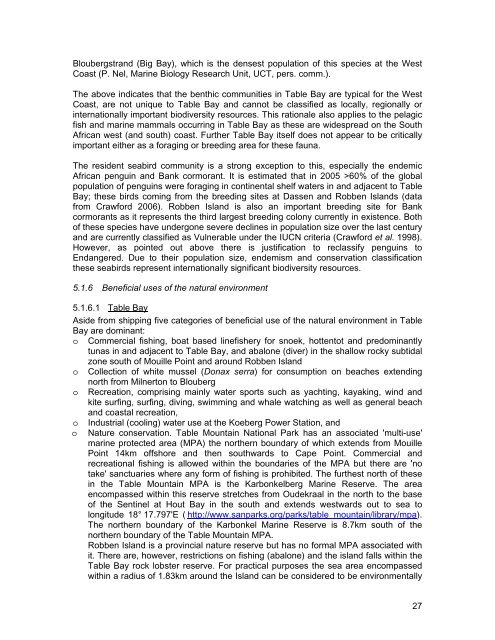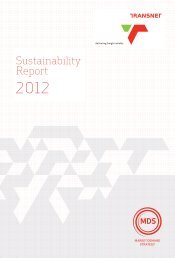BEN SCHOEMAN DOCK BERTH DEEPENING Specialist ... - Transnet
BEN SCHOEMAN DOCK BERTH DEEPENING Specialist ... - Transnet
BEN SCHOEMAN DOCK BERTH DEEPENING Specialist ... - Transnet
You also want an ePaper? Increase the reach of your titles
YUMPU automatically turns print PDFs into web optimized ePapers that Google loves.
Bloubergstrand (Big Bay), which is the densest population of this species at the West<br />
Coast (P. Nel, Marine Biology Research Unit, UCT, pers. comm.).<br />
The above indicates that the benthic communities in Table Bay are typical for the West<br />
Coast, are not unique to Table Bay and cannot be classified as locally, regionally or<br />
internationally important biodiversity resources. This rationale also applies to the pelagic<br />
fish and marine mammals occurring in Table Bay as these are widespread on the South<br />
African west (and south) coast. Further Table Bay itself does not appear to be critically<br />
important either as a foraging or breeding area for these fauna.<br />
The resident seabird community is a strong exception to this, especially the endemic<br />
African penguin and Bank cormorant. It is estimated that in 2005 >60% of the global<br />
population of penguins were foraging in continental shelf waters in and adjacent to Table<br />
Bay; these birds coming from the breeding sites at Dassen and Robben Islands (data<br />
from Crawford 2006). Robben Island is also an important breeding site for Bank<br />
cormorants as it represents the third largest breeding colony currently in existence. Both<br />
of these species have undergone severe declines in population size over the last century<br />
and are currently classified as Vulnerable under the IUCN criteria (Crawford et al. 1998).<br />
However, as pointed out above there is justification to reclassify penguins to<br />
Endangered. Due to their population size, endemism and conservation classification<br />
these seabirds represent internationally significant biodiversity resources.<br />
5.1.6 Beneficial uses of the natural environment<br />
5.1.6.1 Table Bay<br />
Aside from shipping five categories of beneficial use of the natural environment in Table<br />
Bay are dominant:<br />
o Commercial fishing, boat based linefishery for snoek, hottentot and predominantly<br />
tunas in and adjacent to Table Bay, and abalone (diver) in the shallow rocky subtidal<br />
zone south of Mouille Point and around Robben Island<br />
o Collection of white mussel (Donax serra) for consumption on beaches extending<br />
north from Milnerton to Blouberg<br />
o Recreation, comprising mainly water sports such as yachting, kayaking, wind and<br />
kite surfing, surfing, diving, swimming and whale watching as well as general beach<br />
and coastal recreation,<br />
o<br />
o<br />
Industrial (cooling) water use at the Koeberg Power Station, and<br />
Nature conservation. Table Mountain National Park has an associated 'multi-use'<br />
marine protected area (MPA) the northern boundary of which extends from Mouille<br />
Point 14km offshore and then southwards to Cape Point. Commercial and<br />
recreational fishing is allowed within the boundaries of the MPA but there are 'no<br />
take' sanctuaries where any form of fishing is prohibited. The furthest north of these<br />
in the Table Mountain MPA is the Karbonkelberg Marine Reserve. The area<br />
encompassed within this reserve stretches from Oudekraal in the north to the base<br />
of the Sentinel at Hout Bay in the south and extends westwards out to sea to<br />
longitude 18° 17.797'E ( http://www.sanparks.org/parks/table_mountain/library/mpa).<br />
The northern boundary of the Karbonkel Marine Reserve is 8.7km south of the<br />
northern boundary of the Table Mountain MPA.<br />
Robben Island is a provincial nature reserve but has no formal MPA associated with<br />
it. There are, however, restrictions on fishing (abalone) and the island falls within the<br />
Table Bay rock lobster reserve. For practical purposes the sea area encompassed<br />
within a radius of 1.83km around the Island can be considered to be environmentally<br />
27

















